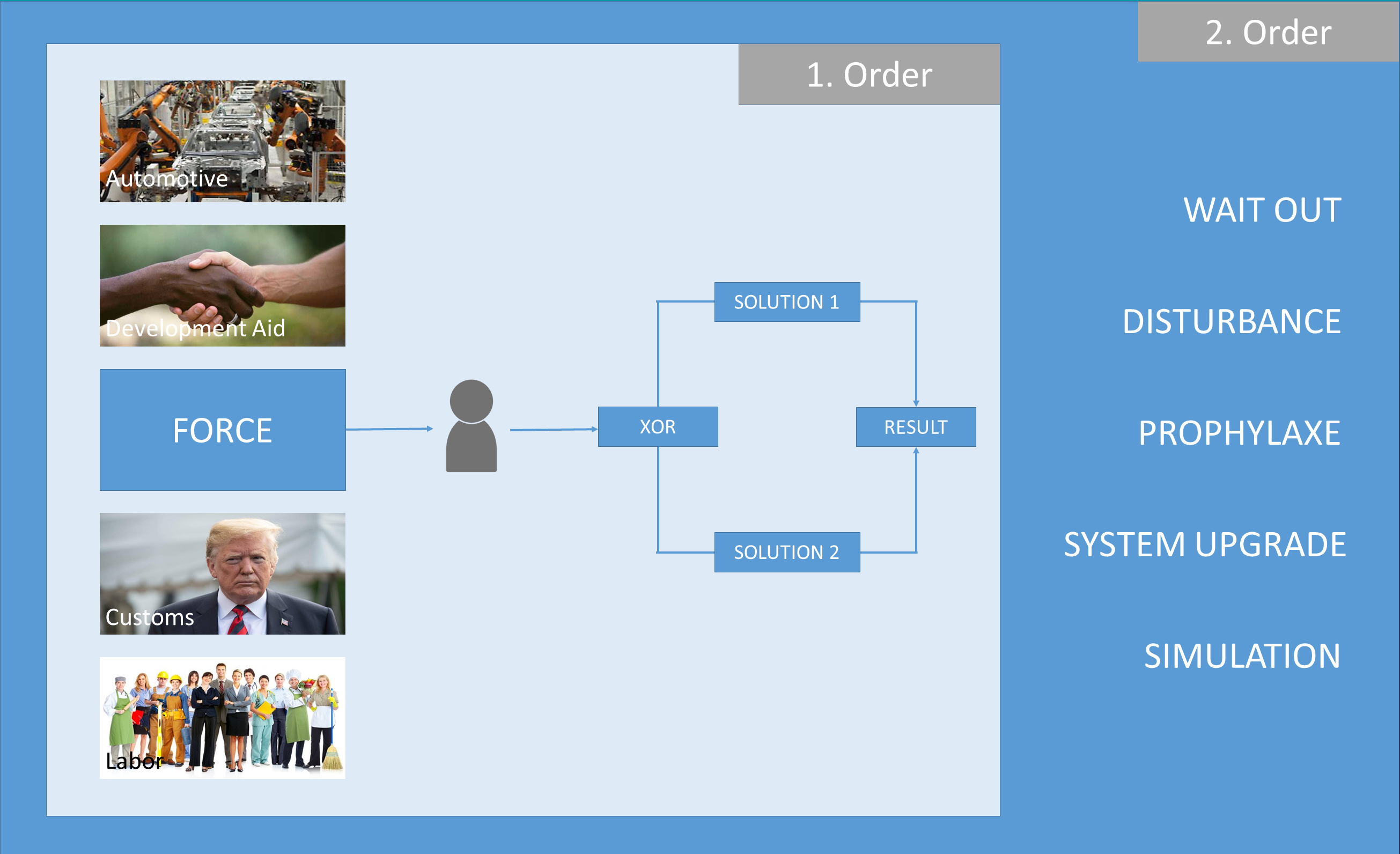Values: The Dilemma
In the Netflix series “Black Mirror” in episode 1.1 the English Prime Minister is woken up by his staff by phone at night. He is told that the Princess Susanna has been kidnapped and is connected with blackmail. The kidnappers demand that the Prime Minister practice sex with a pig in front of the camera and live on TV. This event is to take place and be broadcast the next day at 4 pm.
The time to look for alternatives is therefore very short. Furthermore, there is no channel for negotiations. The head of the cabinet promises “We will use all available resources”. The Prime Minister’s reaction: “No – just a small team and no press. The cabinet has thus imposed a reporting ban and is now trying to solve the problem in the traditional way with a small staff, an intervention force and the press officer. Now the Prime Minister wants to know: “What does the manuscript say?” It quickly turns out that there is no emergency plan for such cases. To make matters worse, a dispute has arisen in the cabinet as to how this problem could be resolved.
All involved now the variant with the Bluescreen and a Pornodarsteller the correct way out appears. Ultimately, however, this also turns out to be unfeasible. A leak in communication made this solution public and thus reached the blackmailers. His reaction was the delivery of a cut off finger to the princess. So there was no alternative but to follow the demands of the blackmailers. The Prime Minister responded to the demands and the live stream was broadcast.
The Prime Minister is forced to take an action in which he can choose from two alternatives, but both lead to the same result. It doesn’t matter if he has sex with the pig or if the princess is murdered. In both cases he loses his political reputation. This is a typical dilemma.
A dilemma occurs when a person (agent) is forced to make a decision by external or internal pressure. He can only choose from two alternatives, which always lead to the same result. If the result is positive, we speak of a constructive dilemma (only very rarely noticed). If the result is (usually) negative, we speak of a destructive dilemma.
There are also situations in which the agent can choose from several alternatives. If there are three, then one speaks of a trilemma. In the case of four choices, from a tetralemma.
A dilemma arises in a closed system. Only these two alternatives are available to the agent. He’s not in a position to think of other options. Not even when he is shown other possibilities from outside. We have often experienced such situations ourselves. No matter what we do, it always turns out negative. Well-intentioned advice from friends cannot be implemented. The reason for this is usually that they simply do not know enough about their own system. Very often you are on your own in such situations. The Prime Minister has also experienced this. Finally, he stayed alone with the pig and the camera.
In addition to these personal dilemmas, there are also manifestations in a larger context. Here are some current examples:
Automotive: The automotive industry currently has to respond to two mainstreams. On the one hand this is the conversion to the electric drive and on the other hand it is the autonomous driving vehicle. If the German automotive industry does not switch to electric drive, the Chinese will do so and export the vehicles to Germany. If the switch is made, German industry will be confronted with cheaper competition from Asia. In both cases, cheaper electric cars will flood the German market and regional industry will lose out. This is the current dilemma facing the German automotive industry.
Import duties: The US economy faces a similar problem. Here, too, there are fears of flooding from the Chinese and European markets. President Trump is now trying to protect his own economy by imposing import duties. This protectionism creates another dilemma. If no tariffs are imposed, American industry will be confronted and weakened by strong global competition. In the case of import duties, the others will react by buying fewer products from the US, which in turn will worsen American industrial production. The behaviour of the American President is incomprehensible to many people. However, according to the dilemma theory, obviously. He has no third alternative, also few friends like the G5 give recommendations.
Development aid: The African continent continues to be at the bottom of the social and economic league table. This was already well known in the middle of the 20th century and attempts are being made to solve this problem with development aid. The solution was to pump money into this continent. This is also a dilemma. If no funding is made available, the countries remain underdeveloped. In the other case, as financial development aid has shown, this has led to corruption and even greater poverty among the population. The problem is still unsolved.
Future of work: All forums and discussions on digitisation will focus on the future of work. The central question here is: “Do we have enough jobs in the future and can we earn enough money to be able to continue our standard of living in the same way? If we do not participate in digitisation, we will very quickly lose our jobs because there are hardly any other jobs. If we participate in digitization, our work platform will be replaced by artificial intelligence – Industry 4.0 and robots. In both cases, work becomes obsolete.
All these and many other examples show that dilemmatic situations can only end negatively. Let us now look at the question of whether there are not solutions to leave this one-way street after all. One thing can already be said in advance for system theoretical considerations:
Dilemmas cannot be solved on the level and in the context in which they arise. Agents simply have no alternative options. Even if they did exist.
Wait out: If the forced decision is not time-critical, one could bet on time. Very often systemic changes occur, which can also postpone and possibly even solve the problem, the dilemma. The Prime Minister said an hour before the live performance, “We still have time.” This was nothing more than a self-calming, because he had no time option by the default of 16 o’clock.
Disturbance: If you have time, you can hope for systemic events that solve the problem almost by themselves. Such events can also be forced. These are then referred to as malfunctions in the system. With this method, you have to construct events that interfere with the system outside the agent’s capability space. The Prime Minister ruled out this alternative from the outset when he said: “Not all of them – just a small team.” Alternatively, the media could have mobilized the entire population to look for the princess.
Prophylaxis: No person or organisation is immune from dilemmatic situations. As the Netflix episode and the examples above show, a solution is hardly possible. The core of the problem lies in the unavailability of additional alternatives. The smaller the circle of life of an entity, the fewer alternatives it has. A person who only ever lives in one workplace, one location or in the same culture has fewer alternatives than a cosmologically living contemporary. To keep dilemmas to a minimum, an ingenious life is a good preventive measure. You can practice this again and again by considering alternatives in everyday situations, even though you don’t actually need them. In response to the Prime Minister’s question: “What does the manuscript say”, there was only the answer that such cases are not planned.
System upgrade: We all live in a section of reality. Because of the sensory systems and the psychological filters it is not possible to perceive the whole reality. To expand your own reality you need additional data and information. Currently, data analytics, evaluation of video cameras, social media and many other digital technologies are available for this purpose. These tools have not yet been available to the Prime Minister. The DNA analysis of the cut finger would also have taken too long. His staff should have involved all systems immediately.
Simulation: In the situation into which it was forced, the agent has only two possible solutions, which always lead to the same negative result. Nor can he take advice from outside, because they know too little about the system and the context. With digital systems, simulations of the affected system can now be built up and alternative solutions can still be identified. Organizations such as the CIA, Mossad, NSA, and many others use these possibilities and neural artificial intelligence. In the case of personal dilemmas, these resources are not available to us. Also, agents would not have the mental capacity to work with it at this point in time. A crisis team as we know it today would have helped the Prime Minister. Such organizations also have a team to test alternative scenarios.
The more complex the world, the more often dilemmas arise. At the same time, however, digitisation provides additional solutions. If we are faced with another personal dilemma, we should know that a solution is possible, but not at the level where the problem arose. Flexibility, intelligence and creativity are very helpful.





 Deutsch
Deutsch English
English